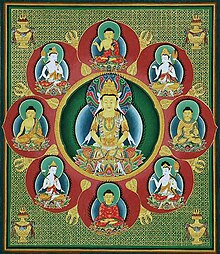| Part of a series on |
| Tibetan Buddhism |
|---|
 |
| Schools |
Key personalities
|
Teachings
|
| Practices and attainment |
| Major monasteries |
| Institutional roles |
| Festivals |
| Texts |
| Art |
| History and overview |
The Five Wisdoms are five kinds of wisdoms which appear when the mind is purified of the five disturbing emotions and the natural mind appears. All of those five wisdoms are represented by one of the five buddha-families.
Meaning and translations
Pañca-jñāna is rendered in English as: "five wisdoms," "five awarenesses," or "five pristine cognitions."
Interpretations
The Five Wisdoms are:
- Tathatā-jñāna, the wisdom of Suchness or Dharmadhatu, "the bare non-conceptualizing awareness" of Śūnyatā, the universal substrate of the other four jñāna;
- Ādarśa-jñāna, the wisdom of "Mirror-like Awareness", "devoid of all dualistic thought and ever united with its 'content' as a mirror is with its reflections"; This type of wisdom is a transformation of the eighth consciousness, the Alayavijnana.
- Samatā-jñāna, the wisdom of the "Awareness of Sameness", which perceives the sameness, the commonality of dharmas or phenomena. This kind of wisdom is a transformation of the seventh consciousness, the Klistamanas. Through this wisdom, a Buddha sees beyond all superficial differentiations and perceives the fundamental of all things as Śūnyatā or emptiness. Such undifferentiation gives rise to equality for all beings. Hence, it is also understood as the wisdom of equality or impartiality.
- Pratyavekṣaṇa-jñāna, the wisdom of "Investigative Awareness", that perceives the specificity, the uniqueness of dharmas. This type of wisdom is a transformation of the sixth consciousness, and is also known as the wisdom of specific knowledge or sublime investigation.
- Kṛty-anuṣṭhāna-jñāna, the wisdom of "Accomplishing Activities", the awareness that "spontaneously carries out all that has to be done for the welfare of beings, manifesting itself in all directions". This type of wisdom is created through the transformation of the five sensory consciousness.
The Five Wisdoms "emerge through a transformation (parāvṛtti) of the eight consciousnesses at the moment of enlightenment".
Five Dhyani Buddhas

The idea of the Five Wisdoms "underwent a considerable development" within Tibetan Buddhism where they are "symbolized or embodied" in the Five Dhyani Buddhas.
According to Bönpo teacher Tenzin Wangyal, the Five Pure Lights become the Five Poisons if we remain deluded, or the Five Wisdoms and the Five Buddha Families if we recognize their purity.
The Five Wisdoms, and the accompanying Five Buddhas, are represented in Tibetan Buddhism by the "symbolic bone ornaments". The Hevajra Tantra associates the Symbolic Bone Ornaments directly with the Five Wisdoms:
- the 'wheel-like' (Tib.: 'khor lo') 'crown ornament' (sometimes called 'crown jewel') (Tib.: gtsug gi nor bu), symbolic of Akshobhya and 'mirror-like pristine awareness' (Ādarśa-jñāna);
- 'earrings' (Tib.: rna cha) represent of Amitabha and pristine awareness of discernment (Pratyavekṣaṇa-jñāna);
- 'necklace' (Tib.: mgul rgyan) symbolizing Ratnasambhava and pristine awareness of total sameness (Samatā-jñāna);
- 'bracelets' (Tib.: lag gdu) and 'anklets' (Tib.: gdu bu) as symbolic of Vairochana and pristine awareness of the ultimate dimension of phenomena (Tathatā-jñāna);
- 'girdle' (Tib.: ske rags) symbolizing Amoghasiddhi and the accomplishing pristine awareness (Kṛty-anuṣṭhāna-jñāna);
The additional ornament spoken of in various texts related to Hevajra is ash from a cremation ground smeared on the body (Tib.: thal chen).
See also
- Buddhabhūmi Sūtra
- Four Dharmadhātu
- Four ways of knowing
- Achintya Bheda Abheda
- Darśana
- Dhyani Buddhas
- Five Powers
- Mahabhuta
- Pancamakara
- Pancatattva
Notes
- Sanskrit: pañca-jñāna; Tibetan: ཡེ་ཤེས་ལྔ, Wylie: ye shes lnga; Japanese: go-chi
- Anger, jealousy, pride, attachment and ignorance
- Ādarśa is Sanskrit for "mirror", the term may be parsed into the etymon of darśana with a grammatical adposition
- Skt: aṣṭhiamudrā; Tib: rus pa'i rgyan phyag rgya
- These are elucidated by a commentary to the Hevajra Tantra by Jamgön Kongtrul.
References
- Rangjung Yeshe Dictionary
- ^ Keown 2003, p. 209.
- ^ The Princeton dictionary of Buddhism. Buswell, Robert E., Jr., 1953-, Lopez, Donald S., Jr., 1952-, Ahn, Juhn. . 2017. ISBN 978-0-19-068115-9. OCLC 1003080564.
{{cite book}}: CS1 maint: location missing publisher (link) CS1 maint: others (link) - Wangyal, Tenzin (author) & Dahlby, Mark (editor). Healing with Form, Energy and Light: The Five Elements in Tibetan Shamanism, Tantra, and Dzogchen. Ithaca, NY, USA: Snow Lion Publications. ISBN 1-55939-176-6
- ^ Kongtrul, Jamgön (author); (English translators: Guarisco, Elio; McLeod, Ingrid) (2005). The Treasury of Knowledge (shes bya kun la khyab pa’i mdzod). Book Six, Part Four: Systems of Buddhist Tantra, The Indestructibe Way of Secret Mantra. Bolder, Colorado, USA: Snow Lion Publications. ISBN 1-55939-210-X (alk.paper) p.493
- refer CH, f. 66a6-b1; where CH = Kongtrul Lodrö Taé, Disclosing the Secret of the Invincible Vajra: Phrase by Phrase Commentary on the Hevajra Tantra Two Examinations (dPal kye'i rdo rje'i rgyud kyi rgyal po brtag pa gnyis pa'i tshig don rnam par 'grol ba bzhom med rdo rje'i gsang ba 'byed pa). Rumtex, Sikkim: Dharma Chakra Centre, 1981.
Sources
Published sources
- Kalupahana, David J. (1991), Buddhist Thought and Ritual, Paragon House
- Keown, Damien (2003), A Dictionary of Buddhism, Oxford University Press, ISBN 0-19-860560-9
- Thrangu Rinpoche (author) & Peter Roberts (translator) (1998). The Five Buddha Families and The Eight Consciousnesses. Boulder, CO, USA: Published by the Namo Buddha Seminar. Source: Archived 2008-07-20 at the Wayback Machine (accessed: November 22, 2007)
Web-sources
- ^ Lone Hansen (Shenphen Chödron), The Five Wisdoms Archived 2014-07-14 at the Wayback Machine
External links
- The Five Wisdoms: Talk five of six on the Buddhist Wisdom teachings. (transcribed talk), by FWBO's Ratnaghosa (accessed: Thursday, November 22, 2007)
